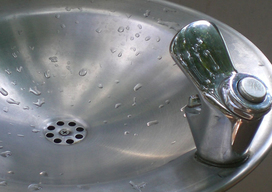School backflow incident
Amended 2 July 2024
A primary school, in the south of England, complained to their local water supplier of warm and discoloured water coming out of their playground drinking fountains. The water supplier was concerned and dispatched a Regulations Officer to inspect and establish the cause.

On arrival a cursory check of one of the drinking water fountains confirmed that the drinking water was discoloured. Worse was to follow, when after a short period steam vapour started to be discharged as well. A fittings inspection of the schools plumbing system was immediately carried out and water samples taken for analysis. Water temperatures taken at the fountain found, instead of the maximum 20⁰C it should have been, the water was in excess of 57⁰C, high enough to cause injury. The school had assumed the discolouration and warm water might be down to old galvanised iron pipes being installed in close proximity to the hot pipes on the domestic plumbing system. Whilst this may have contributed due to the high temperatures something more serious had to be happening and a cross-connection was the chief suspect.
With alarm bells ringing a closer inspection of the plant room revealed a filling loop permanently installed, contravening many installation requirements. This formed a direct connection between the school’s drinking water supply and their central heating system.
The absence of appropriate backflow protection allowed heavily polluted fluids from the heating system to back pressure into the cold water system, contaminating the school’s drinking water supply, as witnessed at the drinking water fountains.
Immediate action was taken to remedy the contraventions and it was extremely fortunate that children did not suffer scalding or illness during this event.
Advice for installers and buildings managers
Commercial primary systems are considered to be a fluid category 4 risk and, subject to a risk assessment, a fluid category 3 filling loop can only ever be used in specific circumstances (see Further advice below). Where the assessment permits the use of a filling loop, the installation requirements are such that:
an isolation valve and double check valve be installed on the drinking water supply;
a second isolation valve is located on the heating circuit at the top-up/filling point; and
the connecting loop or pipe is only to be connected when the system requires to be topped up, and must be removed immediately after use.
Updating procedures
This case highlights the need to ensure that all systems are compliant. Those who are responsible for managing the systems or who are carrying out the work must be aware of the requirements of the regulations and their role in protecting public health.
It is a legal requirement to notify of changes or alterations to plumbing systems in many circumstances. It is recommended that an approved contractor, such as a WaterSafe plumber, is used to carry out plumbing works. Approved contractors can carry out some work without the need to provide advanced notification. In addition a ‘work completed’ certificate will be issued providing a defence should a water supplier query the work.
It is also recommended that the requirements of the regulations are embedded in maintenance procedures and protocols to ensure of ongoing compliance. If you are unsure about your system or need further advice contact your local water supplier. Contact details for water companies can be found here.
Further advice
Advice from water suppliers has been published on the WRAS (now Water Regs UK) website in the guidance section.

